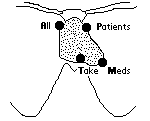Ref: Heart Sounds
- Auscultation sites
- Auscultation order
- Heart sounds: S1, S2,
splitting
- Added sounds: S3, S4,
opening snap, systolic
click
- Murmurs: general considerations,
grading

- Aortic: 2nd right intercostal space.
- Pulmonary: 2nd left intercostal space.
- Tricuspid: 4th intercostal space, at lower left sternal border.
- Mitral: 5th left intercostal space, 1 cm medial to midclavicular line.
- Mitral: bell.
- Mitral diaphragm.
- Tricuspid.
- Aortic.
- Pulmonary.
- Sound:
- Where:
- Why: mitral, tricuspid valves shutting.
- Loud DDx:
• Mitral stenosis.
- Soft DDx:
• MR.
- Sound:
- Where:
- Why: 2 parts: aortic then pulmonary valves shutting [A2, P2].
• Loudness of a component tells it shut with high pressure, so HTN there
in circuit.
- Aortic component loud DDx:
• Aortic HTN.
- Pulmonary component loud DDx:
• Pulmonary HTN.
- Soft DDx:
• AR.
• Calcification of aortic valve.
- Sound:
- Why: either aortic valve shut early or pulmonary shut late.
- Increased normal splitting [wider split when inspire] DDx:
• Delayed RV emptying (pulmonary stenosis, RBBB).
- Fixed wide splitting DDx:
• ASD.
- Sound: in early-mid diastole, low-pitched, "gallop sounding".
- Where: apex, louder on expiration.
- Why: ventricular distension, may be normal.
- DDx:
• Normal in children
• Constrictive pericarditis.
• Mitral regurgitation
• Tricuspid regurgitation
• LVF, RVF
- Sound: higher pitch, late diastole, "gallop sounding"
- Where:
- Why: ventricular filling resistance, always pathologic.
- DDx:
• HTN
• MI
• AS
• Heart block
- Sound: high-pitched click after S2.
- Where: lower L sternal edge.
- Why: stiff mitral valve suddenly opened.
- DDx:
• Mitral stenosis.
- Sound: high-pitched click, soon after S1. Click followed by AS or PS
murmur.
- Where: aortic, pulmonary ausc sites.
- Why: stiff aortic valve suddenly opened.
- DDx:
• AS.
- Can be either systolic or diastolic. Students will only hear systolic.
- Mnemonic for whether murmur is systolic diastolic:
• PASS and PAID:
• Pulmonary, Aortic Stenosis = Systolic.
• Pulmonary, Aortic Insufficiency = Diastolic.
• Then mitral and tricuspid must be opposite to these.
Graded on scale of 1 to 6.
- Only cardiologist can hear.
- Trained doctor can hear.
- Student can hear. No thrill.
- Thrill barely palpable.
- Thrill easily palpable.
- Can hear murmur by being in the room without a stethoscope.

